Opportunities and Challenges to Develop Digital Twins for Subsea Pipelines
Abstract
:1. Introduction
2. Literature Review
2.1. Digital Twin
2.2. Subsea Pipelines and Application of Digital Twin
3. Automated Creation of the Digital Twin during Construction
- Refine the hardware used, and thus the field execution and subsequent data processing workflow.
- Compare the digital twin centreline to the in-line inspection and weld location surveys, and seek to explain variances.
- Make the results more readily available using cloud services and mobile communications to better expose the data to decision-makers.
- Investigate the schedule and cost savings in greater detail.
- Garner more operator feedback on the potential value from a construction quality control or quality assurance perspective.
- Examine long-term impacts on the integrity and general operations and maintenance, as well as on failure investigations.
4. Update of the Digital Twin with Information Acquired in Inspections
5. Maintenance Planning Based on the Digital Twin
6. Fast Assessment of Failures and Inspection Planning
7. Life Extension Assessments
- (1)
- Definition of the operational context and premises for an extended operational period, and identification of new threats.
- (2)
- Assessment of current condition, functionality and integrity of the system (Diagnostic).
- (3)
- Reassessment of the technical lifetime (Prognostic).
- (4)
- Identification of Life Extension measures (Prescriptive).
- (5)
- Development of a Life Extension program.
- (1)
- High-resolution modelling of the asset (RB-FEA).
- (2)
- Update the model to reflect real-world conditions (Digital Twin).
- (3)
- Fatigue calculations based on continuous monitoring.
- (4)
- Statistical correlation between sea states and fatigue damage. Retrospective fatigue calculation.
8. Conclusions
Author Contributions
Funding
Conflicts of Interest
References
- Silva, L.M.R.; Guedes Soares, C. An integrated optimization of the floating and subsea layouts. Ocean Eng. 2019, 191, 106557. [Google Scholar] [CrossRef]
- Silva, L.M.R.; Guedes Soares, C. Oilfield development system optimization under reservoir production uncertainty. Ocean Eng. 2021, 225, 108758. [Google Scholar] [CrossRef]
- DNV GL. 2020/1022: How Digital Tools and Solutions Can Improve Subsea Integrity Management; DNV GL: Oslo, Norway, 2020. [Google Scholar]
- Bhowmik, S. Digital twin of subsea pipelines: Conceptual design integrating IoT, machine learning and data analytics. In Proceedings of the Annual Offshore Technology Conference 2019, Houston, TX, USA, 6–9 May 2019. [Google Scholar] [CrossRef]
- Wanasinghe, T.R.; Wroblewski, L.; Petersen, B.K.; Gosine, R.G.; James, L.A.; de Silva, O.; Mann, G.K.I.; Warrian, P.J. Digital Twin for the Oil and Gas Industry: Overview, Research Trends, Opportunities, and Challenges. IEEE Access 2020, 8, 104175–104197. [Google Scholar] [CrossRef]
- Rosen, R.; von Wichert, G.; Lo, G.; Bettenhausen, K.D. About the importance of autonomy and digital twins for the future of manufacturing. IFAC-PapersOnLine 2015, 48, 567–572. [Google Scholar] [CrossRef]
- Gelernter, D.H. Mirror Worlds: Or the Day Software Puts the Universe in a Shoebox—How It Will Happen and What It Will Mean; Oxford University Press: New York, NY, USA, 1993; OCLC 23868481; ISBN 978-0195079067. [Google Scholar] [CrossRef]
- Grieves, M. Virtually intelligent product systems: Digital and physical twins. In Complex Systems Engineering: Theory and Practice; Flumerfelt, S., Schwartz, K.G., Mavris, D., Briceno, S., Eds.; American Institute of Aeronautics and Astronautics: Reston, VA, USA, 2019; pp. 175–200. [Google Scholar] [CrossRef]
- Li, C.; Mahadevan, S.; Ling, Y.; Choze, S.; Wang, L. Dynamic Bayesian network for aircraft wing health. AIAA J. 2017, 55, 930–941. [Google Scholar] [CrossRef]
- Mandolla, C.; Messeni, A.; Percoco, G.; Urbinati, A. Computers in Industry Building a digital twin for additive manufacturing through the exploitation of blockchain: A case analysis of the aircraft industry. Comput. Ind. 2019, 109, 134–152. [Google Scholar] [CrossRef]
- Magargle, R.; Johnson, L.; Mandloi, P.; Davoudabadi, P.; Kesarkar, O.; Krishnaswamy, S.; Batteh, J.; Pitchaikani, A. A simulation based digital twin for model-driven health monitoring and predictive maintenance of an automotive braking system. In Proceedings of the 12th International Modelica Conference, Prague, Czech Republic, 15–17 May 2017; pp. 35–46. [Google Scholar] [CrossRef] [Green Version]
- Damjanovic-Behrendt, V. A digital twin-based privacy enhancement mechanism for the automotive industry. In Proceedings of the International Conference on Intelligent Systems (IS), Madeira, Portugal, 25–27 September 2018; pp. 272–279. [Google Scholar] [CrossRef]
- Torkamani, A.; Andersen, K.G.; Steinhubl, S.R.; Topol, E.J. High-definition medicine. Cell 2017, 170, 828–843. [Google Scholar] [CrossRef]
- Liu, Y.; Zhang, L.; Yang, Y.; Zhou, L.; Ren, L.; Wang, F.; Liu, R.; Pang, Z.; Deen, M.J. A novel cloud-based framework for the elderly healthcare services using digital twin. IEEE Access 2019, 7, 49088–49101. [Google Scholar] [CrossRef]
- Laaki, H.; Miche, Y.; Tammi, K. Prototyping a digital twin for real time remote control over mobile networks: Application of remote surgery. IEEE Access 2019, 7, 20325–20336. [Google Scholar] [CrossRef]
- Jimenez, J.I.; Jahankhani, H.; Kendzierskyj, S. Health care in the cyberspace: Medical cyber-physical system and digital twin challenges. In Digital Twin Technologies and Smart Cities; Springer: Cham, Switzerland, 2020; pp. 79–92. [Google Scholar] [CrossRef]
- Post, J.; Groen, M.; Klaseboer, G. Physical model based digital twins in manufacturing processes. In Proceedings of the 10th Forming Technology Forum, Enschede, The Netherlands, 12–13 October 2017. [Google Scholar]
- Howard, D. The digital twin: Virtual validation in electronics development and design. In Proceedings of the 2019 Pan Pacific Microelectronics Symposium, Kauai, HI, USA, 11–14 February 2019; pp. 1–9. [Google Scholar] [CrossRef]
- Bilberg, A.; Malik, A.A. Digital twin driven human-robot collaborative assembly. CIRP Ann. 2019, 68, 499–502. [Google Scholar] [CrossRef]
- Mohammadi, N.; Taylor, J.E. Smart city digital twins. In Proceedings of the 2017 IEEE Symposium Series on Computational Intelligence (SSCI), Honolulu, HI, USA, 27 November–1 December 2017; pp. 1–5. [Google Scholar] [CrossRef]
- Ruohomäki, T.; Airaksinen, E.; Huuska, P.; Kesäniemi, O.; Martikka, M.; Suomisto, J. Smart city platform enabling digital twin. In Proceedings of the International Conference on Intelligent Systems (IS), Madeira, Portugal, 25–27 September 2018; pp. 155–161. [Google Scholar] [CrossRef]
- Piascik, R.; Vickers, J.; Lowry, D.; Scotti, S.; Stewart, J.; Calomino, A. Technology Area 12: Materials, Structures, Mechanical Systems, and Manufacturing Road Map; NASA Office of Chief Technologist: Washington, DC, USA, 2010.
- Caruso, P.; Dumbacher, D.; Grieves, M. Product lifecycle management and the quest for sustainable space exploration. In Proceedings of the AIAA SPACE 2010 Conference & Exposition, Anaheim, CA, USA, 30 August–2 September 2010. [Google Scholar] [CrossRef]
- Glaessgen, E.; Stargel, D. The digital twin paradigm for future NASA and US Air Force vehicles. In Proceedings of the 53rd AI—AA/ASME/ASCE/AHS/ASC Structures, Structural Dynamics and Materials Conference, Honolulu, HI, USA, 23–26 April 2012. [Google Scholar] [CrossRef] [Green Version]
- Tuegel, E. The airframe digital twin: Some challenges to realization. In Proceedings of the 53rd AIAA/ASME/ASCE/AHS/ASC Structures, Structural Dynamics and Materials Conference, Honolulu, HI, USA, 23–26 April 2012. [Google Scholar] [CrossRef]
- Maher, D.P. On software standards and solutions for a trusted Internet of Things. In Proceedings of the 51st Hawaii International Conference on System Sciences (HICSS-51), Waikoloa Village, HI, USA, 3–6 January 2018. [Google Scholar] [CrossRef] [Green Version]
- Chen, B.Q.; Videiro, P.M.; Guedes Soares, C. Review of digital twin of ships and offshore structures. In Developments in Maritime Technology and Engineering; Guedes Soares, C., Santos, T.A., Eds.; Taylor and Francis: London, UK, 2021; pp. 445–451. [Google Scholar] [CrossRef]
- Panetta, K. Gartners Top 10 Technology Trends for 2017. Available online: https://www.gartner.com/smarterwithgartner/gartners-top-10-technology-trends-2017/ (accessed on 27 January 2022).
- Cearley, D.W.; Walker, M.J.; Blosch, M. Top 10 Strategic Technology Trends for 2018; Gartner: Stamford, CT, USA, 2017. [Google Scholar]
- Panetta, K. Gartner Top 10 Strategic Technology Trends for 2019. Available online: https://www.gartner.com/smarterwithgartner/gartners-top-10-technology-trends-2019/ (accessed on 27 January 2022).
- Liu, M.; Fang, S.; Dong, H.; Xu, C. Review of digital twin about concepts, technologies, and industrial applications. J. Manuf. Syst. 2021, 58, 346–361. [Google Scholar] [CrossRef]
- Son, Y.H.; Kim, G.-Y.; Kim, H.C.; Jun, C.; Noh, S. Do Past, present, and future research of digital twin for smart manufacturing. J. Comput. Des. Eng. 2021, 9, 1–23. [Google Scholar] [CrossRef]
- Wang, J.; Li, X.; Wang, P.; Liu, Q. Bibliometric analysis of digital twin literature: A review of influencing factors and conceptual structure. Technol. Anal. Strateg. Manag. 2022, 1–15. [Google Scholar] [CrossRef]
- Atalay, M.; Murat, U.; Oksuz, B.; Parlaktuna, A.M.; Pisirir, E.; Testik, M.C. Digital twins in manufacturing: Systematic literature review for physical-digital layer categorization and future research directions. Int. J. Comput. Integr. Manuf. 2022, 1–27. [Google Scholar] [CrossRef]
- Tao, F.; Zhang, M.; Nee, A.Y.C. Five-dimension digital twin modeling and its key technologies. Digit. Twin Driven Smart Manuf. 2019, 63–81. [Google Scholar] [CrossRef]
- Qi, Q.; Tao, F.; Hu, T.; Anwer, N.; Liu, A.; Wei, Y.; Wang, L.; Nee, A.Y.C. Enabling technologies and tools for digital twin. J. Manuf. Syst. 2021, 58, 3–21. [Google Scholar] [CrossRef]
- Tao, F.; Qi, Q. Make more digital twins. Nature 2019, 573, 490–491. [Google Scholar] [CrossRef] [Green Version]
- Guo, B.; Song, S.; Ghalambor, A.; Lin, T.R. Offshore Pipelines: Design, Installation, and Maintenance; Gulf Professional Publishing: Houston, TX, USA, 2013. [Google Scholar] [CrossRef]
- Cai, J.; Jiang, X.; Lodewijks, G. Residual ultimate strength of offshore metallic pipelines with structural damage–a literature review. Ships Offshore Struct. 2017, 12, 1037–1055. [Google Scholar] [CrossRef] [Green Version]
- Bai, Q.; Bai, Y. Subsea Pipeline Design, Analysis, and Installation; Gulf Professional Publishing: Waltham, MA, USA, 2014. [Google Scholar]
- Yazdi, M.; Khan, F.; Abbassi, R. Operational subsea pipeline assessment affected by multiple defects of microbiologically influenced corrosion. Process Saf. Environ. Prot. 2022, 158, 159–171. [Google Scholar] [CrossRef]
- Wang, Z.; Tang, Y.; Guedes Soares, C. Imperfection study on lateral thermal buckling of subsea pipeline triggered by a distributed buoyancy section. Mar. Struct. 2021, 76, 102916. [Google Scholar] [CrossRef]
- Wang, Z.; Tang, Y.; Yang, J.; Guedes Soares, C. Analytical study of thermal upheaval buckling for free spanning pipelines. Ocean Eng. 2020, 218, 108220. [Google Scholar] [CrossRef]
- Bruton, D.A.; Bolton, M.; Carr, M.; White, D. Pipe-soil interaction with flowlines during lateral buckling and pipeline walking —The SAFEBUCK JIP. In Proceedings of the Offshore Technology Conference, Houston, TX, USA, 5–8 May 2008. [Google Scholar] [CrossRef]
- Bruton, D.A.; Carr, M.; Sinclair, F.; MacRae, I. Lessons learned from observing walking of pipelines with lateral buckles, including new driving mechanisms and updated analysis models. In Proceedings of the Offshore Technology Conference, Houston, TX, USA, 3–6 May 2010. [Google Scholar] [CrossRef]
- Chen, B.; Zhang, X.; Guedes Soares, C. The effect of general and localized corrosions on the collapse pressure of subsea pipelines. Ocean Eng. 2022, 247, 110719. [Google Scholar] [CrossRef]
- Zhang, X.; Chen, B.; Guedes Soares, C. Effect of non-symmetrical corrosion imperfection on the collapse pressure of subsea pipelines. Mar. Struct. 2020, 73, 102806. [Google Scholar] [CrossRef]
- Teixeira, A.P.; Guedes Soares, C.; Netto, T.A.; Estefen, S.F. Reliability of pipelines with corrosion defects. Int. J. Press. Vessel. Pip. 2008, 85, 228–237. [Google Scholar] [CrossRef]
- Teixeira, A.P.; Palencia, O.G.; Guedes Soares, C. Reliability analysis of pipelines with local corrosion defects under external pressure. J. Offshore Mech. Arct. Eng. 2019, 141, 1–10. [Google Scholar] [CrossRef]
- Netto, T.A. On the effect of narrow and long corrosion defects on the collapse pressure of pipelines. Appl. Ocean Res. 2009, 31, 75–81. [Google Scholar] [CrossRef]
- ASME. B31G Manual for Determining the Remaining Strength of Corroded Pipelines (Supplement to ASME B31 Code for Pressure Piping); The American Society of Mechanical Engineers: New York, NY, USA, 2012. [Google Scholar]
- DNV. Recommended Practice DNV-RP-F101: Corroded Pipelines; DNV: Oslo, Norway, 2019. [Google Scholar]
- DNV. Standard DNV-ST-F101: Submarine Pipeline Systems; DNV: Oslo, Norway, 2021. [Google Scholar]
- American Petroleum Institute. API Specification 5L—Line Pipe, 46th ed.; American Petroleum Institute: Washington, DC, USA, 2018. [Google Scholar]
- Li, R.; Chen, B.; Guedes Soares, C. Design equation for the effect of ovality on the collapse strength of sandwich pipes. Ocean Eng. 2021, 235, 109367. [Google Scholar] [CrossRef]
- An, C.; Duan, M.; Estefen, S.F.; Su, J. Structural and Thermal Analyses of Deepwater Pipes; Springer: Cham, Switzerland, 2021; ISBN 9783030535391. [Google Scholar] [CrossRef]
- Xia, M.; Kemmochi, K.; Takayanagi, H. Analysis of filament-wound fiber-reinforced sandwich pipe under combined internal pressure and thermomechanical loading. Compos. Struct. 2001, 51, 273–283. [Google Scholar] [CrossRef]
- Estefen, S.F.; Netto, T.A.; Pasqualino, I.P. Strength analyses of sandwich pipes for ultra deepwaters. Trans. ASME J. Appl. Mech. 2005, 72, 599–608. [Google Scholar] [CrossRef]
- Yang, J.; Paz, C.M.; Estefen, S.F.; Fu, G.; Lourenço, M.I. Collapse pressure of sandwich pipes with strain-hardening cementitious composite—Part 1: Experiments and parametric study. Thin-Walled Struct. 2020, 148, 106605. [Google Scholar] [CrossRef]
- Li, R.; Chen, B.Q.; Guedes Soares, C. Effect of ovality length on collapse strength of imperfect sandwich pipes due to local buckling. J. Marit. Sci. Eng. 2022, 10, 12. [Google Scholar] [CrossRef]
- Bhardwaj, U.; Teixeira, A.P.; Guedes Soares, C. Uncertainty in collapse strength prediction of sandwich pipelines. J. Offshore Mech. Arct. Eng. 2022, 144, 041702. [Google Scholar] [CrossRef]
- DNV. Standard DNV-RP-A204: Qualification and Assurance of Digital Twins; DNV: Oslo, Norway, 2021. [Google Scholar]
- Hlady, J.; Glanzer, M.; Fugate, L. Automated creation of the pipeline digital twin during construction—Improvement to construction quality and pipeline integrity. In Proceedings of the 2018 12th International Pipeline Conference, Calgary, AB, Canada, 24–28 September 2018; Volume 2, pp. 1–12. [Google Scholar] [CrossRef]
- Bhowmik, S.; Noiray, G.; Naik, H. Subsea pipeline design automation using digital field twin. In Proceedings of the Abu Dhabi International Petroleum Exhibition & Conference ADIP 2019, Abu Dhabi, United Arab Emirates, 11–14 November 2019. [Google Scholar] [CrossRef]
- Ho, M.; El-Borgi, S.; Patil, D.; Song, G. Inspection and monitoring systems subsea pipelines: A review paper. Struct. Health Monit. 2020, 19, 606–645. [Google Scholar] [CrossRef] [Green Version]
- Kaiser, M.J. The global offshore pipeline construction service market 2017–Part I. Ships Offshore Struct. 2018, 13, 65–95. [Google Scholar] [CrossRef]
- Karuks, E.; Rohn, M. Mechanical Protection Coating for Coated Metal Substrate. U.S. Patent No. 4,395,159, 5 February 1985. [Google Scholar]
- Sumner, G.R. Offshore Pipeline Insulated with a Cementitious Coating. U.S. Patent No. 5,476,343, 19 December 1995. [Google Scholar]
- Bass, R.M.; Newberry, B.L.; Langner, C.G. Annulus for Electrically Heated Pipe-in-Pipe Subsea Pipeline. U.S. Patent No. 6,814,146, 9 November 2004. [Google Scholar]
- Zhang, X.; Duan, M.; Guedes Soares, C. Lateral buckling critical force for submarine pipe-in-pipe pipelines. Appl. Ocean. Res. 2018, 78, 99–109. [Google Scholar] [CrossRef]
- Bhardwaj, U.; Teixeira, A.P.; Guedes Soares, C. Reliability assessment of a subsea pipe-in-pipe system for major failure modes. Int. J. Press. Vessel. Pip. 2020, 188, 104177. [Google Scholar] [CrossRef]
- Bertram, S.J.; Fan, Y.; Raffelt, D.; Michalak, P. An applied machine learning approach to subsea asset inspection. In Proceedings of the Abu Dhabi International Petroleum Exhibition & Conference, ADIPEC 2018, Abu Dhabi, United Arab Emirates, 12–15 November 2018. [Google Scholar] [CrossRef]
- Daily, J.; Peterson, J. Predictive maintenance: How big data analysis can improve maintenance. In Supply Chain Integration Challenges in Commercial Aerospace; Springer: Cham, Switzerland, 2017; pp. 267–278. [Google Scholar] [CrossRef]
- Errandonea, I.; Beltrán, S.; Arrizabalaga, S. Digital Twin for maintenance: A literature review. Comput. Ind. 2020, 123, 103316. [Google Scholar] [CrossRef]
- Swanson, L. Linking maintenance strategies to performance. Int. J. Prod. Econ. 2001, 70, 237–244. [Google Scholar] [CrossRef]
- Shafiee, M. Maintenance strategy selection problem: An MCDM overview. J. Qual. Maint. Eng. 2015, 21, 378–402. [Google Scholar] [CrossRef]
- Ansari, F.; Glawar, R.; Nemeth, T. PriMa: A prescriptive maintenance model for cyber-physical production systems. Int. J. Comput. Integr. Manuf. 2019, 32, 482–503. [Google Scholar] [CrossRef] [Green Version]
- Werner, A.; Zimmermann, N.; Lentes, J. Approach for a holistic predictive maintenance strategy by incorporating a digital twin. Procedia Manuf. 2019, 39, 1743–1751. [Google Scholar] [CrossRef]
- Vathoopan, M.; Johny, M.; Zoitl, A.; Knoll, A. Modular fault ascription and corrective maintenance using a digital twin. IFAC-PapersOnLine 2018, 51, 1041–1046. [Google Scholar] [CrossRef]
- Rajesh, P.K.; Manikandan, N.; Ramshankar, C.S.; Vishwanathan, T.; Sathishkumar, C. Digital twin of an automotive brake pad for predictive maintenance. Procedia Comput. Sci. 2019, 165, 18–24. [Google Scholar] [CrossRef]
- Strohmeier, F.; Schranz, C.; Guentner, G. i-maintenance: A digital twin for smart maintenance. ERCIM News 2018, 115, 12–14. [Google Scholar]
- Liu, Z.; Chen, W.; Zhang, C.; Yang, C.; Chu, H. Data super-network fault prediction model and maintenance strategy for mechanical product based on digital twin. IEEE Access 2019, 7, 177284–177296. [Google Scholar] [CrossRef]
- Bashiri, M.; Badri, H.; Hejazi, T.H. Selecting optimum maintenance strategy by fuzzy interactive linear assignment method. Appl. Math. Model. 2011, 35, 152–164. [Google Scholar] [CrossRef]
- Arzaghi, E.; Abaei, M.M.; Abbassi, R.; Garaniya, V.; Chin, C.; Khan, F. Risk-based maintenance planning of subsea pipelines through fatigue crack growth monitoring. Eng. Fail. Anal. 2017, 79, 928–939. [Google Scholar] [CrossRef]
- Nikoo, H.M.; Bi, K.; Hao, H. Effectiveness of using pipe-in-pipe (PIP) concept to reduce vortex-induced vibrations (VIV): Three-dimensional two-way FSI analysis. Ocean Eng. 2018, 148, 263–276. [Google Scholar] [CrossRef]
- Shabani, M.M.; Shabani, H.; Goudarzi, N.; Taravati, R. Probabilistic modelling of free spanning pipelines considering multiple failure modes. Eng. Fail. Anal. 2019, 106, 104169. [Google Scholar] [CrossRef]
- Li, X.; Zhang, Y.; Abbassi, R.; Khan, F.; Chen, G. Probabilistic fatigue failure assessment of free spanning subsea pipeline using dynamic Bayesian network. Ocean Eng. 2021, 234, 109323. [Google Scholar] [CrossRef]
- Ferreira, A.D.M.; Afonso, S.M.B.; Willmersdorf, R.B.; Lyra, P.R.M. Multiresolution analysis and deep learning for corroded pipeline failure assessment. Adv. Eng. Softw. 2021, 162–163, 103066. [Google Scholar] [CrossRef]
- Bhowmik, S. Digital twin for offshore pipeline corrosion monitoring: A deep learning approach. In Proceedings of the Offshore Technology Conference, Houston, TX, USA, 16–19 August 2021. OTC-31296-MS. [Google Scholar] [CrossRef]
- Hameed, H.; Bai, Y.; Ali, L. A risk-based inspection planning methodology for integrity management of subsea oil and gas pipelines. Ships Offshore Struct. 2021, 16, 687–699. [Google Scholar] [CrossRef]
- Bhardwaj, U.; Teixeira, A.P.; Guedes Soares, C. Reliability assessment of corroded pipelines with different burst strength models. In Developments in Maritime Technology and Engineering; Guedes Soares, C., Santos, T.A., Eds.; Taylor and Francis: London, UK, 2021; Volume 1, pp. 687–696. [Google Scholar] [CrossRef]
- Bhardwaj, U.; Teixeira, A.P.; Guedes Soares, C.; Samdani Azad, M.; Punurai, W.; Asavadorndeja, P. Reliability assessment of thick high strength pipelines with corrosion defects. Int. J. Press. Vessel. Pip. 2019, 177, 103982. [Google Scholar] [CrossRef]
- Bhardwaj, U.; Teixeira, A.P.; Guedes Soares, C. Uncertainty in reliability of thick high strength pipelines with corrosion defects subjected to internal pressure. Int. J. Press. Vessel. Pip. 2020, 188, 104170. [Google Scholar] [CrossRef]
- Seo, J.K.; Cui, Y.; Mohd, M.H.; Ha, Y.C.; Kim, B.J.; Paik, J.K. A risk-based inspection planning method for corroded subsea pipelines. Ocean Eng. 2015, 109, 539–552. [Google Scholar] [CrossRef]
- Stadie-Frohbös, G.; Lampe, J. Risk based inspection for aged offshore pipelines. In Proceedings of the ASME 32nd International Conference on Ocean, Offshore and Arctic Engineering, Nantes, France, 9–14 June 2013; American Society of Mechanical Engineers: New York, NY, USA, 2013; p. V02BT02A024. [Google Scholar] [CrossRef]
- ABS. Guide for Surveys Using Risk-Based Inspection for the Offshore Industry; American Bureau of Shipping: Houston, TX, USA, 2003.
- API. Risk-Based Inspection. API-RP-580, 3rd ed.; American Petroleum Institute: Washington, DC, USA, 2016. [Google Scholar]
- ASME. B31G—Manual for Determining the Remaining Strength of Corroded Pipelines; Technical Report; ASME: New York, NY, USA, 1991. [Google Scholar]
- Singh, M.; Markeset, T. A methodology for risk-based inspection planning of oil and gas pipes based on fuzzy logic framework. Eng. Fail. Anal. 2009, 16, 2098–2113. [Google Scholar] [CrossRef]
- Liu, X.; Zheng, J.; Fu, J.; Nie, Z.; Chen, G. Optimal inspection planning of corroded pipelines using BN and GA. J. Pet. Sci. Eng. 2018, 163, 546–555. [Google Scholar] [CrossRef]
- Priyanka, E.B.; Thangavel, S.; Gao, X.Z.; Sivakumar, N.S. Digital twin for oil pipeline risk estimation using prognostic and machine learning techniques. J. Ind. Inf. Integr. 2022, 26, 100272. [Google Scholar] [CrossRef]
- Priyanka, E.B.; Thangavel, S.; Prabhakaran, P. Rank-based risk target data analysis using digital twin on oil pipeline network based on manifold learning. Proc. Inst. Mech. Eng. Part E J. Process Mech. Eng. 2022. [Google Scholar] [CrossRef]
- Franklin, J.G.; Stowell, B.E.; Jee, T.P.; Hawkins, M. Standardizing the approach for offshore pipeline lifetime extension. In Proceedings of the Abu Dhabi International Petroleum Exhibition and Conference ADIPEC 2008, Abu Dhabi, United Arab Emirates, 3–6 November 2008; Volume 3, pp. 1354–1360. [Google Scholar] [CrossRef]
- Selman, A.; Hubbard, R. How to age gracefully—Pipeline life extension. In Proceedings of the SPE Asia Pacific Oil & Gas Conference and Exhibition, Perth, Australia, 25–27 October 2016. [Google Scholar] [CrossRef]
- Ferreira, N.N.; Martins, M.R.; de Figueiredo, M.A.G.; Gagno, V.H. Guidelines for life extension process management in oil and gas facilities. J. Loss Prev. Process Ind. 2020, 68, 104290. [Google Scholar] [CrossRef]
- Norwegian Oil and Gas Association. Guideline 122—Norwegian Oil and Gas Recommended Guidelines for the Management of Life Extension; Norwegian Oil and Gas Association: Forus, Norway, 2017. [Google Scholar]
- ISO/TS 12747; Petroleum and Natural Gas Industries—Pipeline Transportation Systems—Recommended Practice for Pipeline Life Extension. ISO: Geneva, Switzerland, 2011.
- NORSOK Y-002; Life Extension for Transportation System. NORSOK: Oslo, Norway, 2010.
- NORSOK Y-009; Life Extension for Subsea Systems. NORSOK: Oslo, Norway, 2011.
- Altamiranda, E.; Colina, E. A system of systems digital twin to support life time management and life extension of subsea production systems. In Proceedings of the OCEANS 2019, Marseille, France, 17–20 June 2019. [Google Scholar] [CrossRef]
- Knezevic, D.; Fakas, E.; Riber, H.J. Predictive digital twins for structural integrity management and asset life extension—JIP concept and results. In Proceedings of the SPE Offshore Europe Conference and Exhibition, OE 2019, Aberdeen, UK, 3–6 September 2019; pp. 1–6. [Google Scholar] [CrossRef]
- Rasheed, A.; San, O.; Kvamsdal, T. Digital twin: Values, challenges and enablers from a modeling perspective. IEEE Access 2020, 8, 21980–22012. [Google Scholar] [CrossRef]
- Sharma, P.; Knezevic, D.; Huynh, P.; Malinowski, G. RB-FEA based digital twin for structural integrity assessment of Offshore structures. In Proceedings of the Annual Offshore Technology Conference, Houston, TX, USA, 30 April–3 May 2018; Volume 4, pp. 2942–2947. [Google Scholar] [CrossRef]
- Theyab, M.A. Fluid flow assurance issues: Literature review. SciFed J. Pet. 2018, 2, 1–11. [Google Scholar]
- Balakin, B.V.; Lo, S.; Kosinski, P.; Hoffmann, A.C. Modelling agglomeration and deposition of gas hydrates in industrial pipelines with combined CFD-PBM technique. Chem. Eng. Sci. 2016, 153, 45–57. [Google Scholar] [CrossRef]

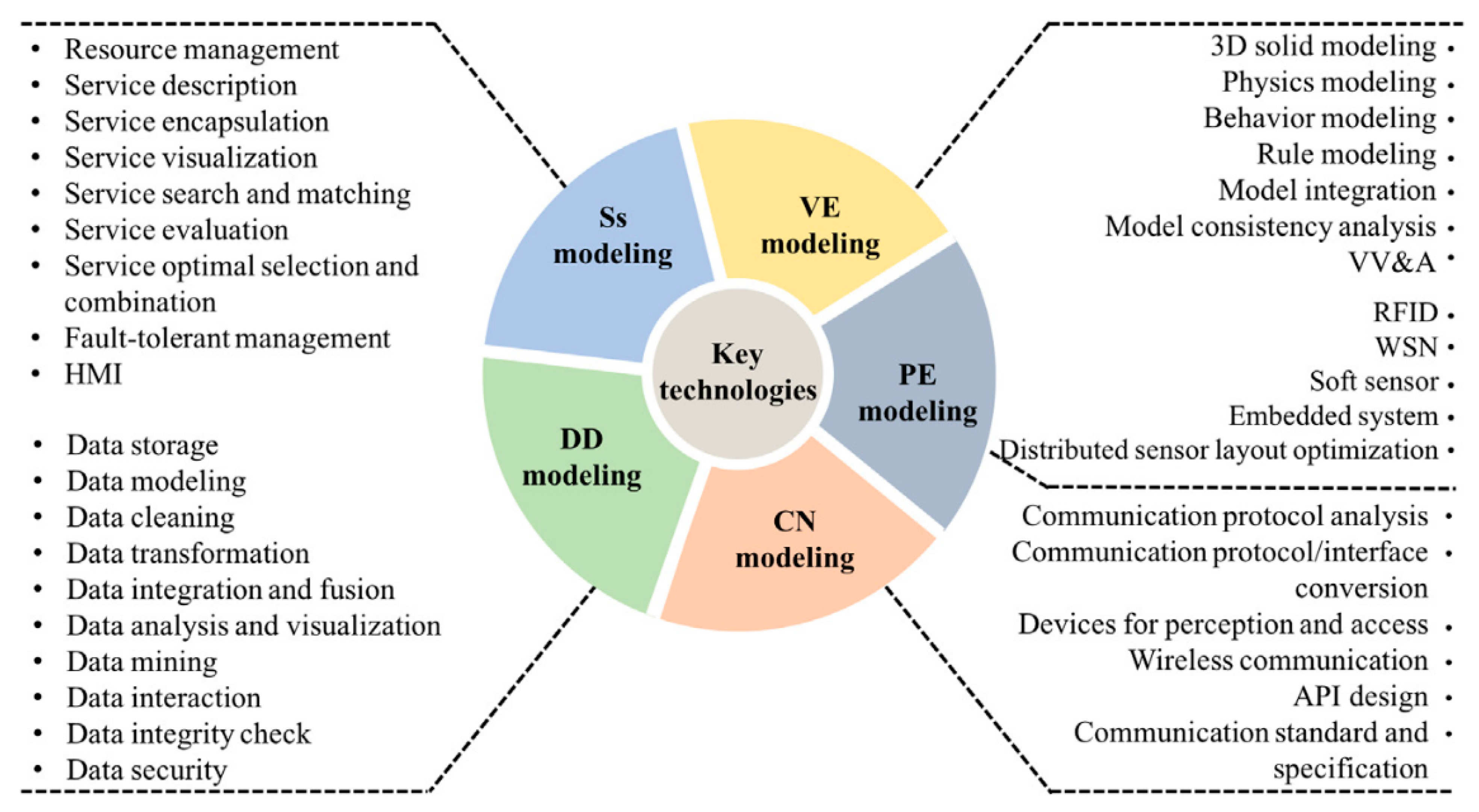
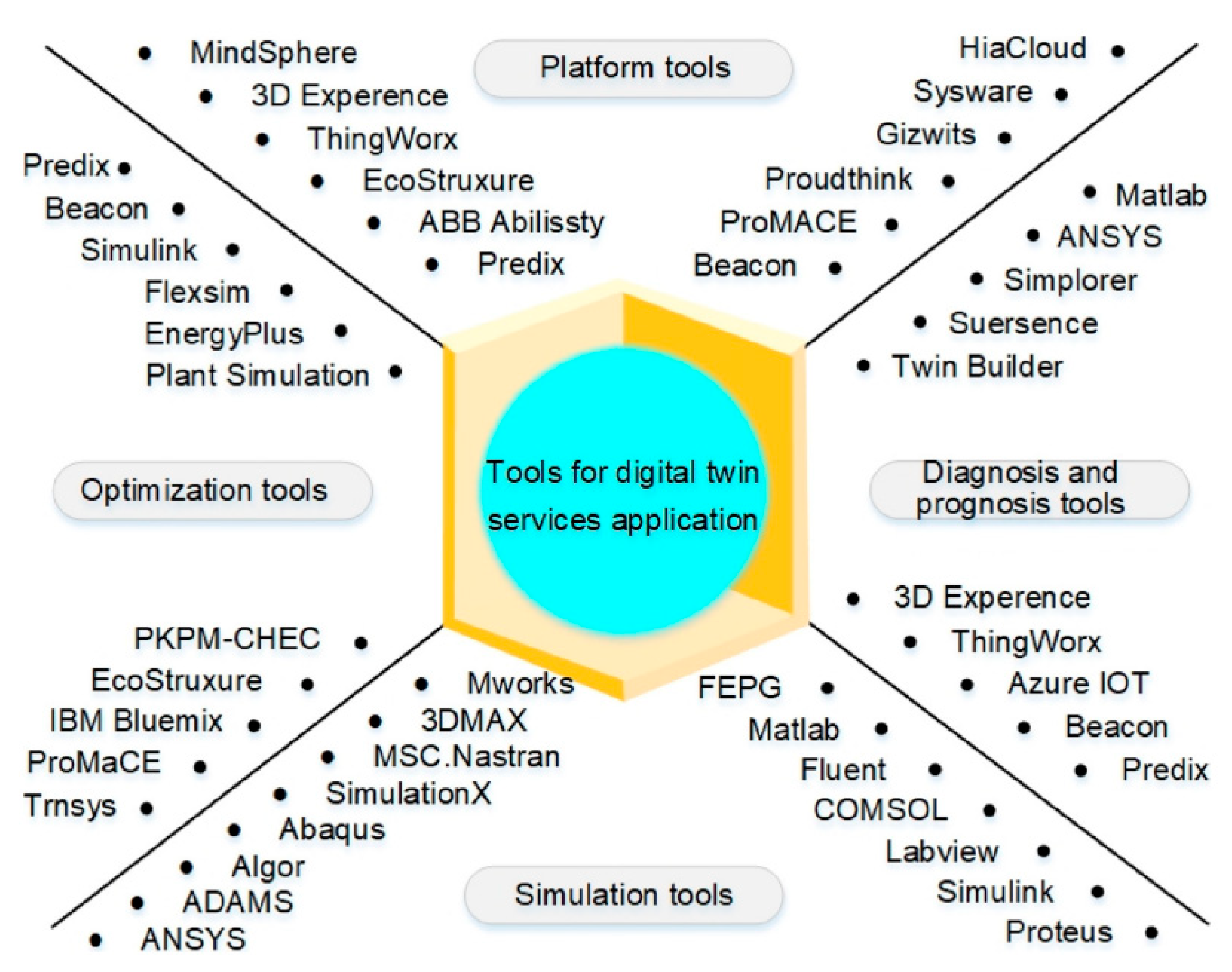
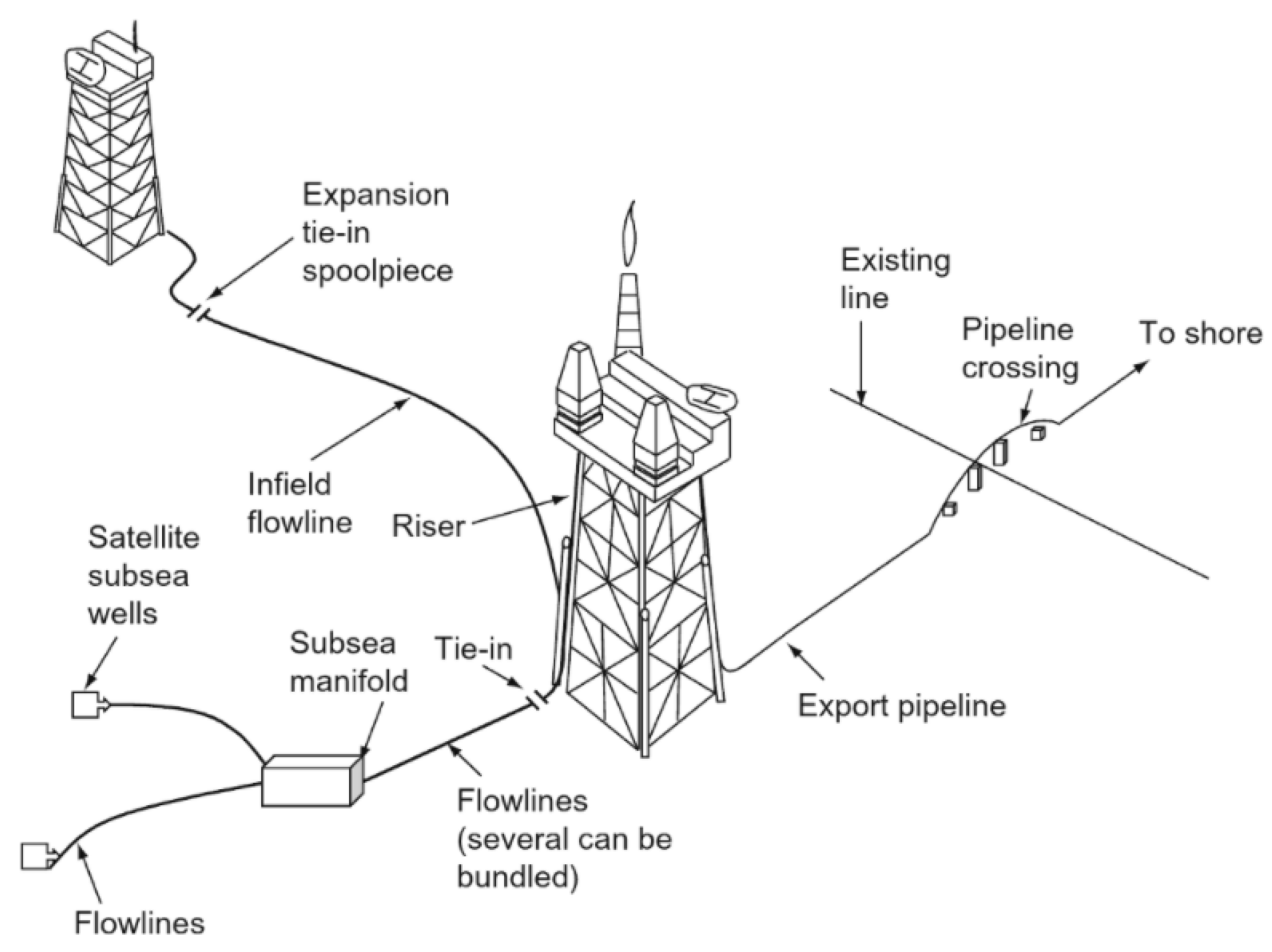
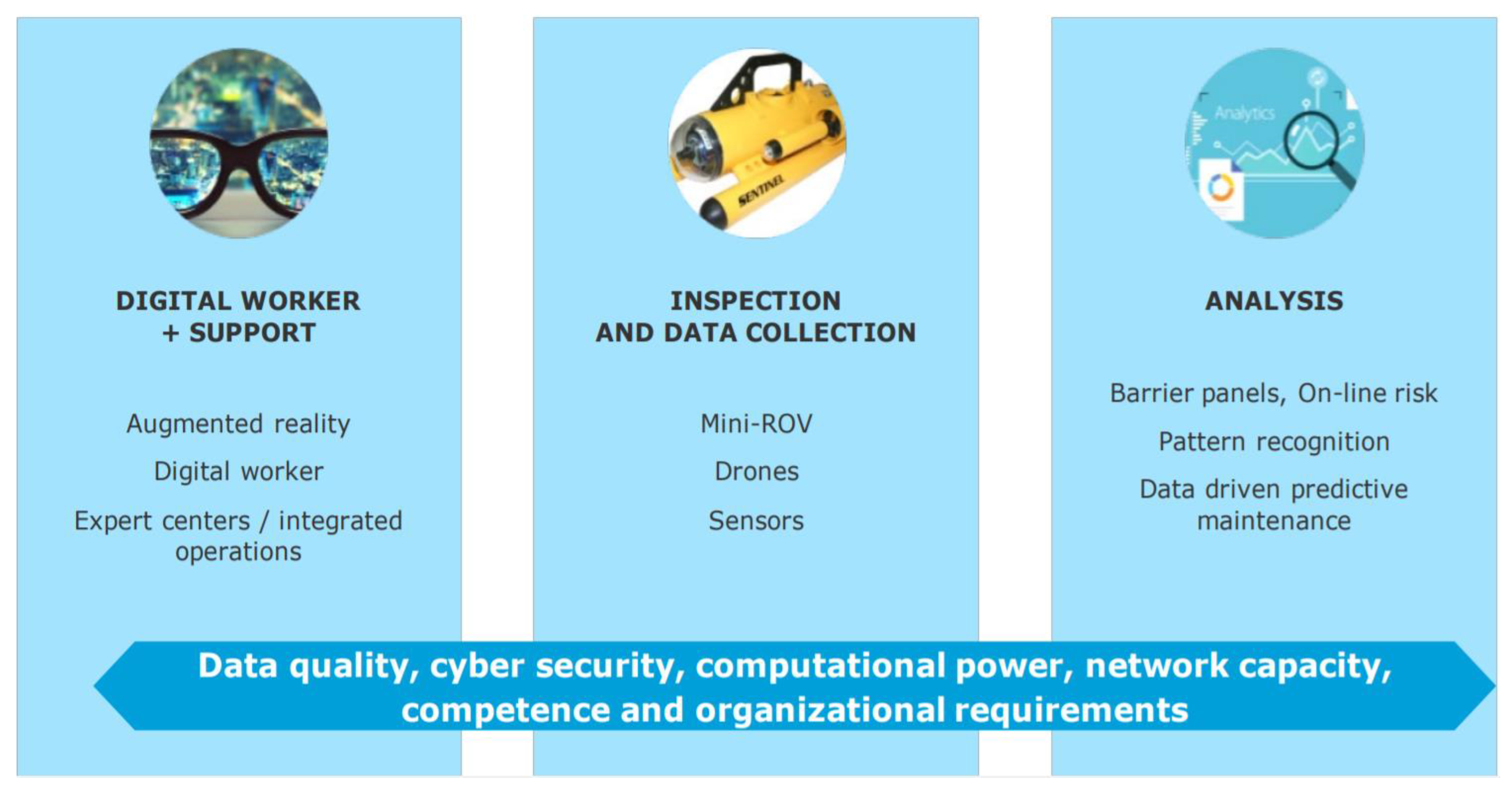

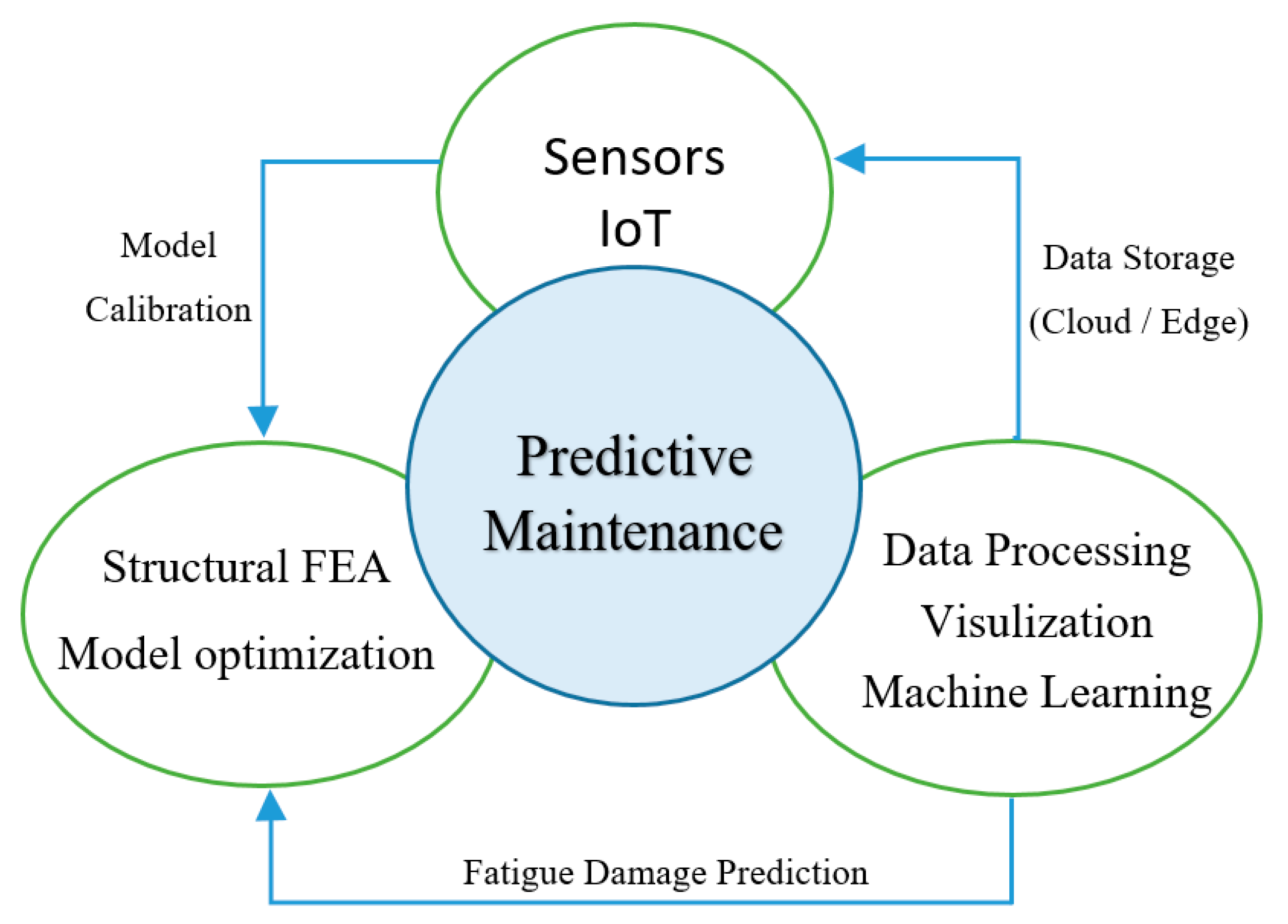
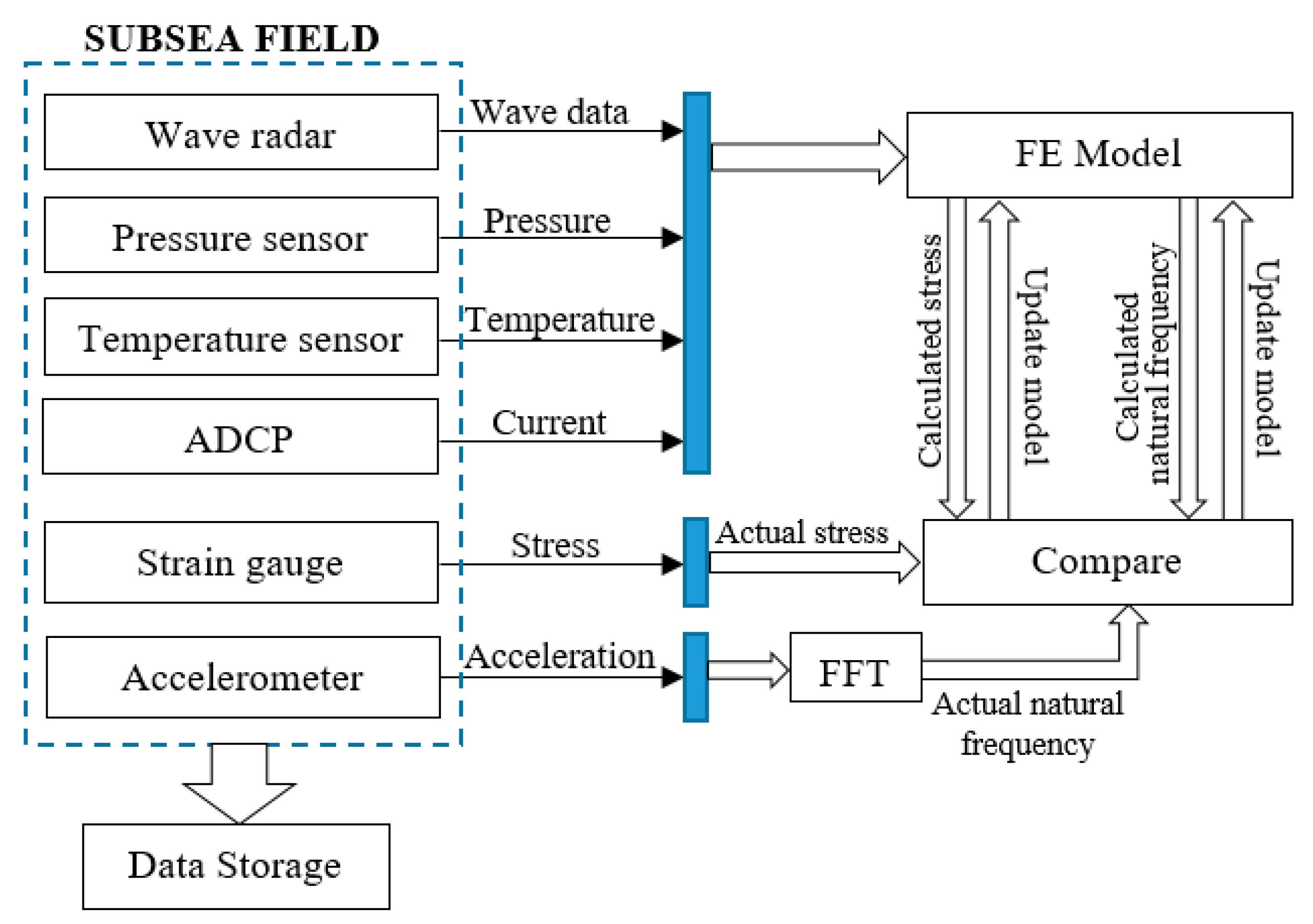

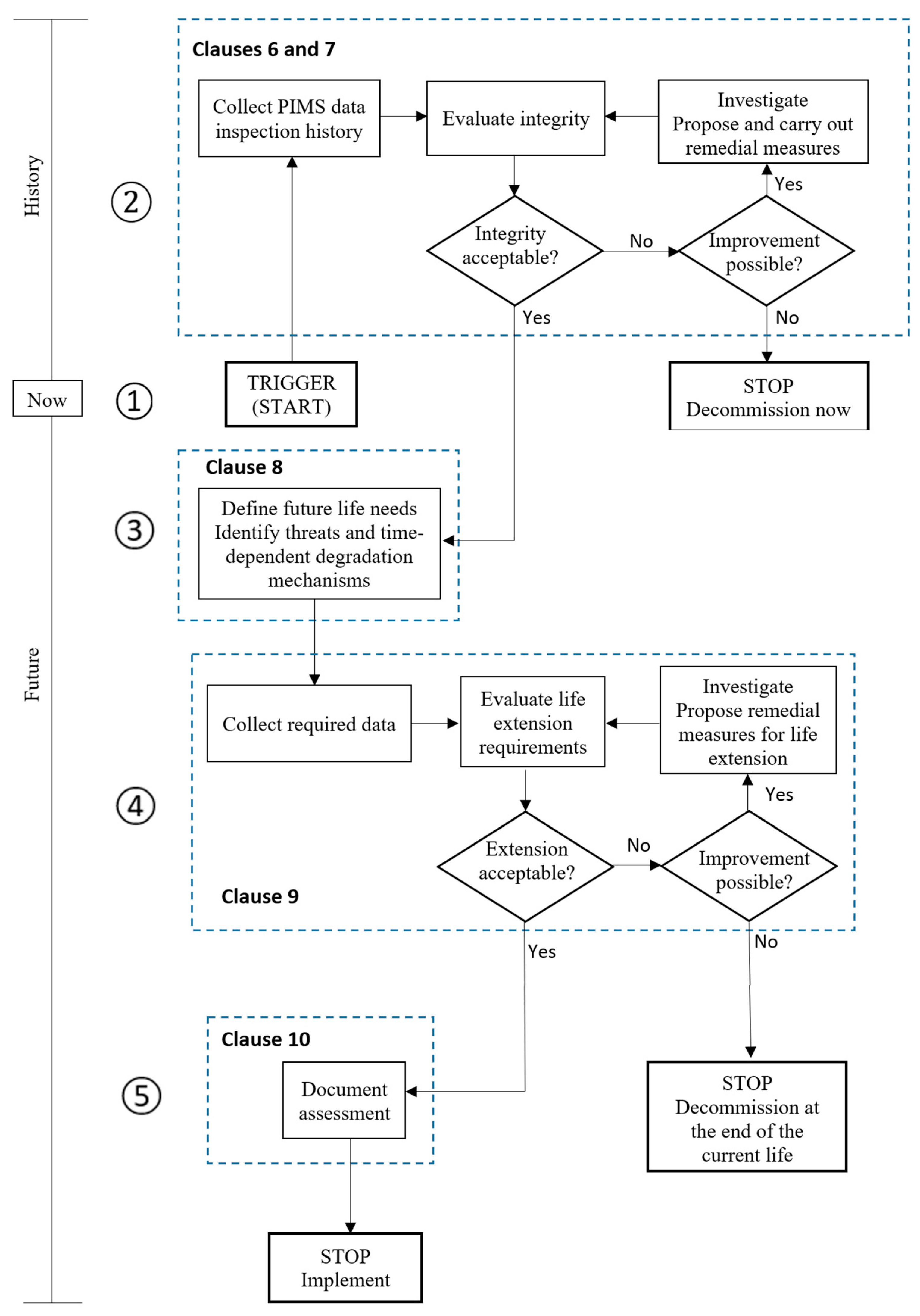
| Application | Reference Number | Year of Publication | Type of Document |
|---|---|---|---|
| Construction | [63] | 2018 | Conference |
| Design | [4] | 2019 | Conference |
| Design | [18] | 2019 | Conference |
| Life extension | [110] | 2019 | Conference |
| Life extension | [111] | 2019 | Conference |
| Maintenance | [11] | 2017 | Conference |
| Maintenance | [74] | 2020 | Journal |
| Maintenance | [78] | 2019 | Journal |
| Maintenance | [79] | 2018 | Journal |
| Maintenance | [80] | 2019 | Journal |
| Maintenance | [81] | 2018 | Magazine |
| Maintenance | [82] | 2019 | Journal |
| Manufacturing | [6] | 2015 | Journal |
| Manufacturing | [10] | 2019 | Journal |
| Manufacturing | [17] | 2017 | Conference |
| Manufacturing | [32] | 2021 | Journal |
| Monitoring | [89] | 2021 | Conference |
| Risk assessment | [101] | 2022 | Journal |
| Risk assessment | [102] | 2022 | Journal |
| Risk assessment | [113] | 2018 | Conference |
Publisher’s Note: MDPI stays neutral with regard to jurisdictional claims in published maps and institutional affiliations. |
© 2022 by the authors. Licensee MDPI, Basel, Switzerland. This article is an open access article distributed under the terms and conditions of the Creative Commons Attribution (CC BY) license (https://creativecommons.org/licenses/by/4.0/).
Share and Cite
Chen, B.-Q.; Videiro, P.M.; Guedes Soares, C. Opportunities and Challenges to Develop Digital Twins for Subsea Pipelines. J. Mar. Sci. Eng. 2022, 10, 739. https://doi.org/10.3390/jmse10060739
Chen B-Q, Videiro PM, Guedes Soares C. Opportunities and Challenges to Develop Digital Twins for Subsea Pipelines. Journal of Marine Science and Engineering. 2022; 10(6):739. https://doi.org/10.3390/jmse10060739
Chicago/Turabian StyleChen, Bai-Qiao, Paulo M. Videiro, and C. Guedes Soares. 2022. "Opportunities and Challenges to Develop Digital Twins for Subsea Pipelines" Journal of Marine Science and Engineering 10, no. 6: 739. https://doi.org/10.3390/jmse10060739
APA StyleChen, B.-Q., Videiro, P. M., & Guedes Soares, C. (2022). Opportunities and Challenges to Develop Digital Twins for Subsea Pipelines. Journal of Marine Science and Engineering, 10(6), 739. https://doi.org/10.3390/jmse10060739








